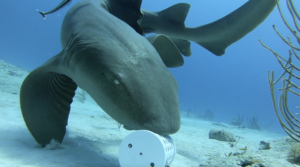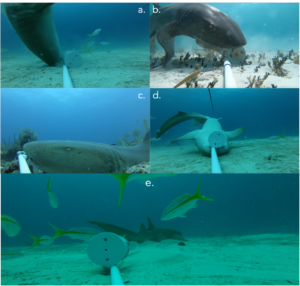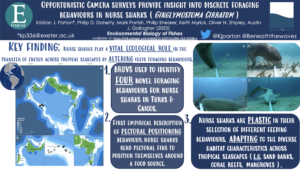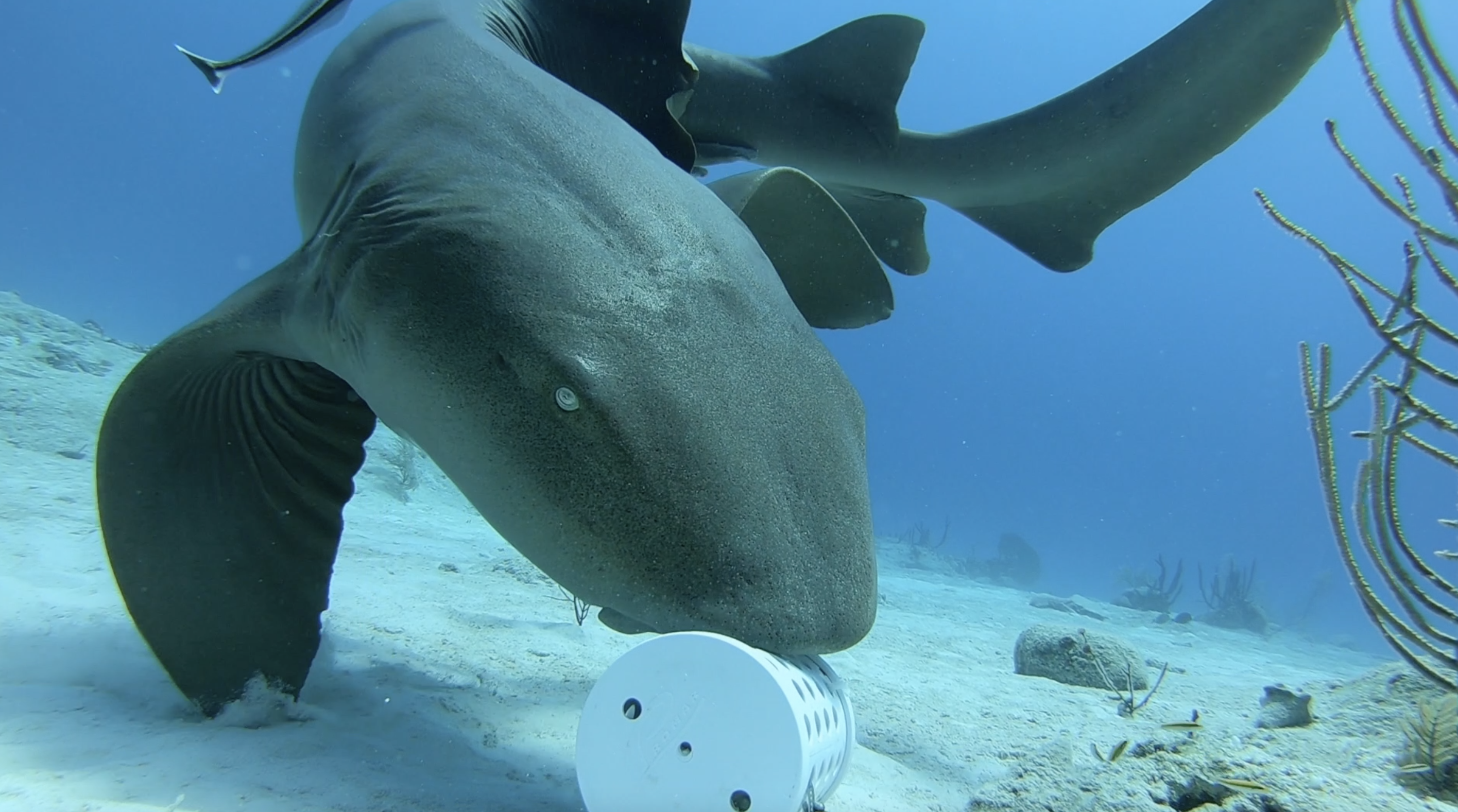University of Exeter research associate Kristian Parton recently published a paper investigating the variety of foraging behaviours exhibited by nurse sharks in The Turks and Caicos Islands. Read on as we hear from him about this exciting research:

Kristian Parton – Research Associate, University of Exeter
Hi Kristian, thank you for joining me. Why don’t we start with a little about yourself and your work?
Hi, my name is Kristian, and I am a research associate at the University of Exeter. I studied my undergraduate degree here back in 2014 in Zoology and then went on to study my Masters by Research, looking at the impact of plastic pollution on sharks. Since then, I’ve been doing bits of research on sharks with various companies, which leads on to this current research with a company called Beneath the Waves, a shark NGO over in the United States.
Brilliant. So tell us, what led to your new paper “Opportunistic camera surveys provide insight into discrete foraging behaviours in nurse sharks (Ginglymostoma cirratum).”?
Over the lockdown in 2020, whilst like most of us I couldn’t get out anywhere, Beneath the Waves were in the Turks and Caicos Islands dropping baited remote underwater video systems in an attempt to look at the biodiversity of sharks around the islands. There’s not that much research that’s been done in the Turks and Caicos on sharks and rays, so Beneath the Waves were using these BRUVS to see what species were out there. For those of you who are new to BRUVS, they stand for Baited Remote Underwater Video Systems, and essentially, they are rigs which are dropped to the seafloor with a camera attached, plus a pole with a bait cannister on it. That bait will then lure in any marine predators like sharks and rays, which are viewed on the camera. Usually, they are used to study abundance and distribution of different species in an area.
As part of my work for Beneath the Waves, I was analysing the BRUVS footage. This involved going through and identifying the various shark and ray species which were coming onto the cameras. As I was looking through the footage, I started to notice the nurse sharks were doing something slightly strange and were behaving differently around the bait cannister to the other sharks that were featuring on the BRUVS, like the Caribbean reef sharks.
Whilst most of the other shark species would just hit the bait cage quite hard and pull it around, the nurse sharks would spend far longer, approaching the bait from different angles and positions. I started posing a few questions and went back to the team at Beneath the Waves. They’d also seen a clip of a nurse shark that looked like it was using its pectoral fins, bending them and arching them, to almost ‘walk’ on the seafloor around this BRUV. So, I started looking at more of the videos back-to-back, and we saw some patterns developing. These nurse sharks were all doing similar behaviours on the BRUVs. And so this paper was an attempt to classify those different behaviours.

Nurse shark (Ginglymostoma cirratum) interacting with bait cannister
And what did you go on to find?
We found that nurse sharks have a variety of different foraging behaviours they can use. We went through and classified four foraging behaviours and one non-foraging behaviour. The first behaviour is vertical feeding, where the shark has positioned its body above the bait cage, with their head down and a vertical posture in the water. Then we’ve got the pectoral positioning behaviour, which we said looked like walking, where the sharks are arching and bending one or both of their pectoral fins, touching them against the sea floor and then using them to propel and move themselves around the bait. Then we’ve got the stationary horizontal feeding behaviour, so this is where a shark is horizontally positioned with its head close to the bait cage. It can be performed at different angles but generally the shark is flat, lying motionless on the seafloor and just sucking at the bait cage. Then we’ve got the ventral feed, where the shark is almost flipped upside down onto it’s back, with its belly facing upwards towards the surface and is trying to get underneath the bait cage. The final behaviour is the swim pass with the shark just swimming past the BRUV and not interacting with the bait cage.

BRUV footage of nurse shark foraging behaviours.
So, after classifying those different behaviours, we wanted to see what the purpose of these behaviours was and if there were any trends. Was depth affecting those behaviours? Was habitat type affecting those behaviours? We found that depth did affect one of the behaviours, which was the swim pass behaviour. In deeper water the sharks were swimming past less than they were in shallower water. This is potentially because nurse sharks could be feeding at deeper depths. However, this was not directly related to the foraging behaviours. We also wanted to compare the different foraging behaviours and whether they differed in sandy bank habitats, compared to reef habitats. Putting all the stats together we did find that the stationary horizontal feeding behaviour was more common on the bank habitats, the behaviour where they’re lying almost motionless on the seafloor. That’s probably because that behaviour is an easy behaviour to perform, it doesn’t require a lot of energy. They can simply lie there on a sandy bank habitat because there’s nothing obstructing them like there would be on a reef habitat, where corals might be getting in the way.
We didn’t find any trends between the other foraging behaviours based on habitat type, but we do think, even though we couldn’t prove it with the stats, that those more complex behaviours, like the vertical feed, are probably more common on the reef habitats. They could be used by the nurse shark to traverse their way around rocks and corals, and that might make it easier for them to get to that bait.
We also looked at the pectoral positioning behaviour, which we loosely termed as ‘walking’, although that’s a very human way of looking at it. We had another scientist come on board who knows a lot about the inner muscle workings of nurse shark pectoral fins. Unlike many other shark species, nurse sharks have specific skeletal and muscular adaptations of their pectoral fins that allow them to bend them in that way. This is similarly seen in the epaulette shark, a relative of the nurse shark, which we know is a species which can truly walk across rocks using its pectoral fins. We think that potentially nurse sharks and epaulette sharks have similar adaptations in their pectoral fins that allow them to exhibit this behaviour.
And so why is this research important?
When we look at this in real world terms, if we remove the bait, in a complex reef habitat a nurse shark might be trying to get to prey that could be hiding under rocks and corals. The range of different foraging behaviours they can use helps them capture that prey when they might be in tricky habitats. They can use the different behaviours in their repertoire.
This research therefore illustrates the behavioural adaptability of nurse sharks across a variety of habitats and provides further understanding of their ecological role, as we know quite little about them.

Summary of Kristian’s paper: Opportunistic camera surveys provide insight into discrete foraging behaviours in nurse sharks (Ginglymostoma cirratum).
Have BRUVS been used to look at behaviours like this before?
BRUVS really haven’t been used to analyse behaviour that much in the way that we’ve used it in this paper. It has been done in the literature but its not the normal way that scientists use BRUVS. Generally, they’re used to look at relative abundance and species diversity across space and time and so this was an interesting way to look at behaviour.
Obviously, there are limitations to using BRUVS in this way. We have to think about the fact that we are using bait, a simulated food offering, to attract sharks and observe their behaviour. The behaviours we observe are influenced by the fact that we’ve lured the sharks in. We posed however that the alternative is too difficult. The number of hours in the water it would take for people to observe these behaviours naturally, we just wouldn’t collect enough data. We also have to consider other challenges, for example not being able to differentiate between individuals on the BRUVS. So, it could be only one or two sharks that are performing these behaviours. We did counter for that by spacing these BRUVS around the islands, in many different areas, so we would obviously hope its not just one shark moving from one to the next. But overall, it was a really interesting piece of work and it was great to work with Beneath the Waves on this, alongside scientists at the University of Exeter.

